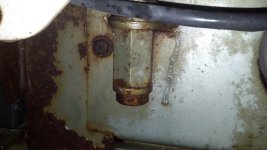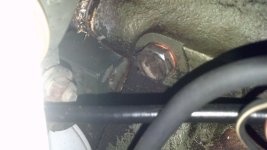rScotty
Super Member
- Joined
- Apr 21, 2001
- Messages
- 8,289
- Location
- Rural mountains - Colorado
- Tractor
- Kubota M59, JD530, JD310SG. Restoring Yanmar YM165D
I've still got a question arising from having put one of those 3 gauge mini sets on our YM165d maybe 25 years back....This is the analog kind of gauges with little 1" clockface dials. Mounts under the dash. Total cost back then was definitely under $50. Luckily for me the gauge and mount came with a bag of pipe threaded adapters. I say "luckily" because the stock threads that Yanmar taps into the engine block for fluid connections are not at all what I expected.... even if they are darn near to being NPT. Anyway, Yanmar's block threads do turn out to be the same as most Japanese cars/tractor/motors use. Guess that's why they were in the bag.
After unscrewing the stock oil pressure sender from the motor, one of the adapters provided was used to mount a plumber's brass "T" into the hole where the oil pressure sender used to live. With this "T" in place, one side of the "T" could mount the sender for the idiot light and the other side sent pressure to the new gauge. It makes sense to have an idiot light for the oil pressure and it's simple. No reason not to do so.
I forget just how, but something similar must have been done to the charging gauge because the lights and gauge both work on that system too.
BUT...and here comes the question....eventually..... ...... I didn't do the temperature idiot light in the same way because because it seemed better to insert the new temperature sender deep into the block just like the original temperature sender had been.
...... I didn't do the temperature idiot light in the same way because because it seemed better to insert the new temperature sender deep into the block just like the original temperature sender had been.
And I already knew that an overheating idiot light was redundant because having overheated it once my hair still stands up remembering the sound the blow-off valve made. An instant reminder that I was sitting three feet from a 16 hp steam whistle......Railroads and bull elephants probably still pause on that date in simple admiration of the sound. I thought the world had ended.
No idiot light could compete with that. An overflow bottle would muffle the sound, but those early thermosiphon systems didn't come with such niceties as an overflow bottle. Just a hose to spray overheated fluid onto the ground and away from the driver.
All of which is just the long way to say that I don't know if there is an alternate water jacket access for the temperature idiot light.
So that's my question: Is anyone who has accessory gauges also running the stock temperature sender/idiot light as well as a sender for a temperature gauge?? If so, how so?
thanks, rScotty
..............
After unscrewing the stock oil pressure sender from the motor, one of the adapters provided was used to mount a plumber's brass "T" into the hole where the oil pressure sender used to live. With this "T" in place, one side of the "T" could mount the sender for the idiot light and the other side sent pressure to the new gauge. It makes sense to have an idiot light for the oil pressure and it's simple. No reason not to do so.
I forget just how, but something similar must have been done to the charging gauge because the lights and gauge both work on that system too.
BUT...and here comes the question....eventually.....
And I already knew that an overheating idiot light was redundant because having overheated it once my hair still stands up remembering the sound the blow-off valve made. An instant reminder that I was sitting three feet from a 16 hp steam whistle......Railroads and bull elephants probably still pause on that date in simple admiration of the sound. I thought the world had ended.
No idiot light could compete with that. An overflow bottle would muffle the sound, but those early thermosiphon systems didn't come with such niceties as an overflow bottle. Just a hose to spray overheated fluid onto the ground and away from the driver.
All of which is just the long way to say that I don't know if there is an alternate water jacket access for the temperature idiot light.
So that's my question: Is anyone who has accessory gauges also running the stock temperature sender/idiot light as well as a sender for a temperature gauge?? If so, how so?
thanks, rScotty
..............

